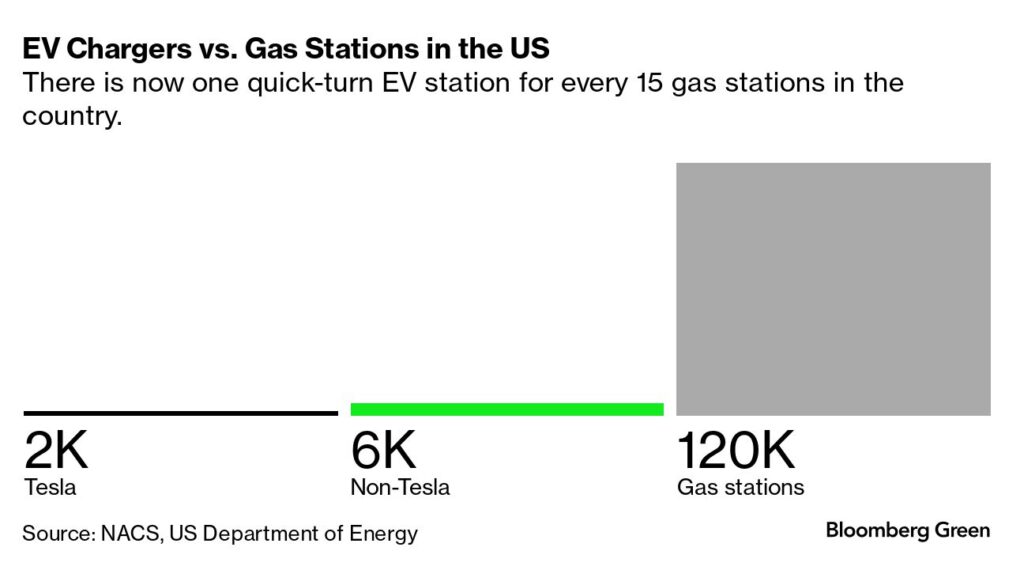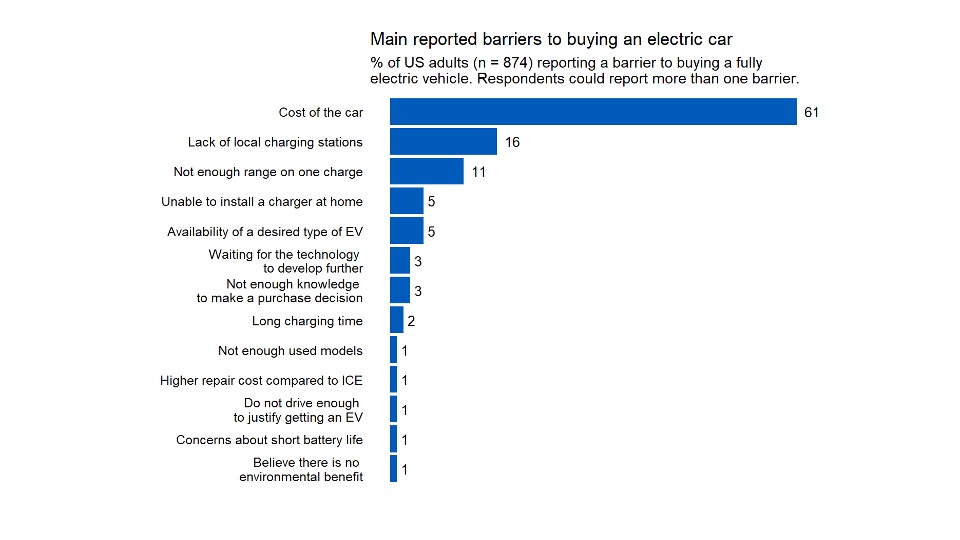Journey to Electric Vehicles: Motivations, Challenges, and Behavioral Insights
Despite a host of financial incentives for purchasing an EV, barriers still stand in the way of their widespread adoption. We set out to learn what those barriers are, and how behavioral insights might overcome them.
Choosing to drive a fully electric vehicle (EV) is one of the most impactful actions an American can adopt to help reduce their emissions that contribute to climate change. While federal and many state incentives for EVs are already in place, people still need to take advantage of them for their potential to be realized. Understanding people’s motivations and barriers to driving EVs can help policymakers, environmental organizations, and other EV advocates to design more effective behavior change and marketing campaigns.
In July 2023, we conducted eight hour-long qualitative interviews – four with current EV drivers and 4 with people that considered an EV, but ultimately decided not to get one. Our sample was diverse in ethnicity, income, and location (seven states and Washington, D.C.).
Here’s what we learned.
Why do people want to drive electric?
People care about the environment and want to do something about it
People that we spoke to were strongly motivated by the environmental benefits of owning and driving an electric vehicle. Several people mentioned that their environmental concern developed over the years, prompting them to consider the impact of their daily actions on the climate.
In the last decade we’ve both become more conscious of climate change and how our footprint matters for those things….I have two young children. It’s gonna be their world as they get older. So it definitely helps from a climate perspective to be able to drive an emissions free vehicle.” (Michael W., 44, Male, New Jersey, EV driver)
The environment, it’s like this constant guilt on you, right? I always felt guilty every time I hit a break. You’re like: Dang it, not again…I only need a car that takes me from point A to B while not hurting or harming anything else…We thought let’s look into electric car options so that at least we’re not doing this nonsense to the environment every day.” (Wendy G., 51, Female, Georgia, EV driver)
Others mentioned that pressure from family, friends, or colleagues and how their environmental stance or green actions motivated them to consider an EV.
I work in the energy and sustainability field. I wanted to practice what I preach. I don’t want to be out there convincing people that they should be doing one thing, when I’m not doing that. I wanted to try to start moving away from brown energy and fossil fuels.” (Evan K., 37, Male, Maryland, considered an EV in the past year)
Our qualitative insights on the relevance of environmental motivations are broadly aligned with a 2023 polling data from the Pew Research Center:
| Among those who would consider purchasing an EV, about seven-in-ten say helping the environment (72%) and saving money on gas (70%) are major reasons why. A small share (12%) cite keeping up with the latest trends in vehicles as a major reason. |
People want to drive fuel-efficient vehicles
The desire for fuel efficiency went hand in hand with wanting to save money on gas. Several people mentioned that seeing an increase and significant fluctuations in gas prices in the past 2 years has further prompted them to re-evaluate their current vehicle.

People who drove inefficient cars and trucks were in particular looking to cut down their monthly spending on fuel.
We had just come back from a trip in Japan, and we saw these tiny cars and we realized: Efficiency, right? That’s pretty important! It [the weather] was really hot and it felt very much like a present on our mind to improve that…Our Jeep was just not fitting our needs. We were paying $400 a month [on gas].” (Marlen N., 33, Female, New York, considered an EV in the past year)
Tax credits and other perks made a switch easier
Federal tax credits and state-level incentives played an important role in convincing people to pull the trigger on an EV, as they helped bring the cost of an EV closer to a comparable gas-powered car.
Not paying a sales tax and the government giving you $7,500 and never having to get your car inspected for emissions, getting to drive in the HOV lanes. There’s just so many positives to it…Combined with the incentives, I got an incredible deal.” (Michael W., 44, Male, New Jersey, EV driver)”
What is stopping people from jumping on the EV bandwagon?
Perceptions of a charging infrastructure
According to Bloomberg Green, in 2024 US now has a fast EV-charging station for every 15 gas stations. The main concern from both adopters and non-adopters revolves around the visibility and density (or lack thereof) of charging stations. Many feel there are not yet enough stations available to make EVs convenient, comparing their scarcity to the ubiquity of gas stations. Despite this, most people that we spoke to believe that the charging infrastructure will catch up and it’s just a matter of time.
I feel like I rarely or I’m not seeing enough of the charging stations. I think when I’m consistently seeing more charging stations or charging options, maybe not as many as gas stations, but it just still feels too inconvenient…But I think within 5, for sure, 10 years, I think that probably over 50% [of cars] are going to be electric.” (Bradley P., 29, Male, Illinois, considered an EV in the past year)

Added hassle
Beyond the simple act of charging, people were turned off by other inconveniences associated with EVs, including limited range in colder weather and inconvenient placement of charging stations. Add to that the additional time needed to plan a road trip, driving electric felt like a hassle, even for those that were excited to get one.
Don’t put charging stations in the middle of nowhere, on the side of a road. Put them at a rest stop so you can at least have a meal while you wait half an hour. It’s just crazy, there’s no thought given to these things…” (Michael W., 44, Male, New Jersey, EV driver)
Upfront vehicle costs
While EVs offer cost savings on fuel, the initial investment remains a concern for many. Recent price reductions in certain EV models indicate a shift toward broader accessibility, yet upfront costs continue to be a significant barrier in people’s decision-making process.
Rare’s quantitative survey from 2019 revealed that the cost of the car, perceived or real lack of charging stations, and range on a single charge remain the most cited barriers preventing people from purchasing an EV.

How can behavioral science accelerate transition to EVs?
As America accelerates towards a clean energy future, understanding the nuances of consumers’ choices is important. Our conversations with both EV adopters and those hesitant to take the leap helped us understand the factors shaping these decisions. From genuine environmental concerns and the practicality of fuel efficiency, to inconveniences and the uncertainty of charging infrastructure, it is evident that the journey to electrification of vehicles is not a straight path.
However, the silver lining lies in the shared optimism among those that we spoke to: with time and strategic interventions, EVs can become the norm on the roads rather than the exception. To this end, behavioral science offers pathways to support people’s decision to go electric, while overcoming obstacles to adoption.
Here are four strategies to accelerate transition to EVs:
- Leverage social influence. Our insights indicate that a driver’s reference network – neighbors, family, and colleagues – can influence someone’s decision to consider an EV. Increasing people’s awareness and visibility of EV adopters within one’s peer group may motivate consideration and adoption. This is especially important since most people would trust the opinions of their friends and family more than other sources, in particular car salesmen.
- Appeal to people’s emotions. Several people mentioned a concern for their children and their future as a motivating factor behind their environmental choices. In marketing and communication messages, consider testing frames that describe the impact of people’s actions on the health and well-being of future generations, compared to broad environmental messaging or other benefits of EVs. For example, the messages to new families might highlight the benefits of cleaner air and the safety of EVs.
- Use loss aversion to your advantage. People feel more pain from potentially losing something than joy they would feel at gaining something of equal value. Consider developing (and testing) messages that highlight the average savings from driving an EV compared to a gas-powered car. For example, these messages can be framed in terms of “losing or wasting money on gas.”
- Create the feeling of urgency. Use the principle of scarcity to highlight limited-time offers or the exclusive benefits available for EVs right now. This can make the opportunity to buy an EV more attractive and potentially prompt quicker decision-making.
- Highlight uncertainty and offer a resolution. Leverage people’s general dislike of ambiguity and uncertainty by drawing attention to volatile and steadily rising gas prices, positioning EVs as a more stable and predictable choice when it comes to the cost of running the car.
The Inflation Reduction Act unlocked billions in federal funding towards clean energy and infrastructure. However, financial incentives are only a piece of the puzzle. Shifting perceptions, harnessing the power of community and social norms should be a more widely-used strategy in driving the broad adoption of EVs.